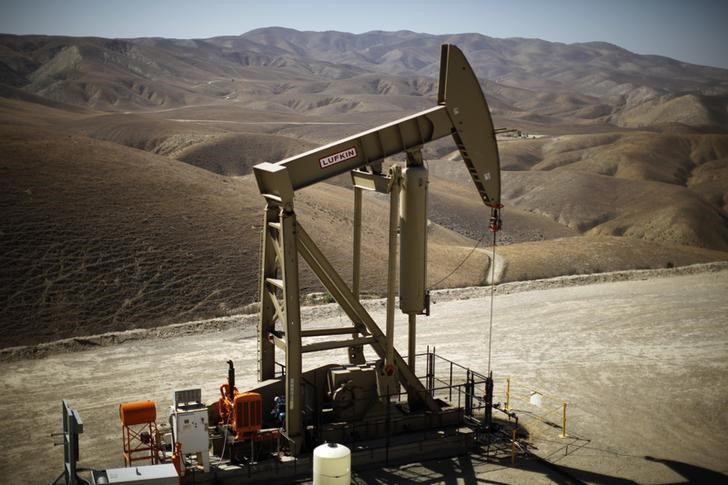By Alexander Villegas and Eliana Raszewski
ANELO, Argentina (Reuters) – Argentina’s new market-friendly government and fears about oil supplies from the Middle East and elsewhere are fueling a boom in drilling and production activity in Argentina’s Patagonian south, home to the giant Vaca Muerta shale formation , Spanish for ‘Dead Cow’. .”
Shale oil and gas production is booming in the flat, arid landscape. Fracking wells are being drilled at record speed, pipelines are being built to bring gas north to the capital Buenos Aires – and ultimately further once the liquefied facilities come on line.
“Our energy future is being built here,” proclaims a huge blue billboard from state energy giant YPF outside the shale town of Anelo, where new houses are being built at a rapid pace. The city’s population grew by 10% last year.
Argentina’s embattled government, led by pro-industry libertarian President Javier Milei, is boosting oil and gas exports to bring in the foreign currency needed to build reserves, and is also rolling out sweeteners for big investments.
Vaca Muerta, an area the size of Belgium, has the second largest shale gas reserves in the world and the fourth largest for shale oil. It is still a relative frontier on the global energy landscape and has great promise.
Investors are more than ready to welcome a new and stable source of oil and LNG at a time of increasing conflict in the oil-rich Middle East, while gas giant Russia wages war in Ukraine and Venezuela remains a pariah.
In oil towns like Anelo, the rapid increase in activity is clear: just a few decades ago it was a sleepy hamlet with a handful of houses. Now there are hotels, restaurants and even a casino for the energy industry workers who flock there.
“The boom is already here,” said Monica Paredes, 70, one of Anelo’s first residents, as she sat outside her home of nearly half a century near the town’s central square. “There used to be nothing here, nothing.”
The local governor says Anelo has added 1,000 residents in the past year. This has put pressure on local infrastructure, posing a wider challenge to growth.
Thousands of oil executives are flocking to the region for a major energy summit starting on Wednesday, with infrastructure, LNG export plans and energy deals on the table. Hotels in and around the capital Neuquen are fully booked.
“The growth is so staggering that the infrastructure cannot keep up with the rate of population growth,” said José Luis Sureda, Argentina’s former minister of hydrocarbon resources.
GLOBAL ENERGY PLAYER IN 2030?
Vaca Muerta has the potential to become a crown jewel for Argentina, which has been struggling with economic crises for years, with depleted foreign exchange reserves, triple-digit inflation and political shifts between left and right.
Some of these concerns remain, but libertarian Milei has changed the mood among investors, rolling out policies aimed at boosting the private sector and austerity measures to get the economy back in order – even as poverty has risen .
An investment incentive program gives major projects in areas such as energy and mining tax breaks and better access to controlled foreign exchange markets, encouraging investment.
“We have planned an investment of $1.2 billion in our Rincón de Aranda field, to increase our oil production tenfold,” Horacio Turri, executive director of exploration and production at major local producer Pampa Energy, told Reuters.
He added that the biggest challenge for the sector was making the leap into exports, which could see energy becoming as important as cash crops soy and corn to the agriculture-driven economy.
“We believe that Vaca Muerta can make a similar contribution to the entire agricultural sector by 2030,” he said.
The main obstacle remains getting the logistics in order. Argentina still lacks LNG export capacity, which will take years to fully develop. Local roads, schools and homes in places like Anelo still have to catch up.
Sureda, the former hydrocarbon resources minister, said new oil development will outpace gas production in coming years as oil becomes easier to ship to global markets despite pipeline bottlenecks. Gas faces a more complicated challenge: a lack of factories to turn it into LNG for export.
“Vaca Muerta can supply 2 million barrels per day without any problem,” Sureda added. Argentina’s shale oil production is currently around 400,000 barrels per day.
“But that requires other things: more infrastructure to bring the oil to the ports, and many more people in the labor market and more equipment.”
More and more people are starting to believe in the dream that Argentina could become a serious global energy player. The number of fracking wells for the extraction of shale oil and gas has increased enormously this year. The investments have run out. Production reaches records.
“Argentina, if all goes well, could be a global player by 2030,” said Daniel Dreizzen, director of consultancy Aleph Energy and former minister of energy planning.
One of the key concerns for energy companies is Argentina’s ability to build out its pipelines and gas export terminals. A major LNG terminal deal between YPF and Malaysia’s Petronas is faltering, industry insiders say, underscoring the challenge.
Even if it goes ahead, it would take years and billions of dollars.

“Oil is very profitable, but gas needs more infrastructure,” said Dreizzen, who predicted that annual sector investment could almost double to around $23 billion over the next eight years.
“You have to build pipelines, liquefy them, transport them, compete with the United States. It’s a long-term project.”


